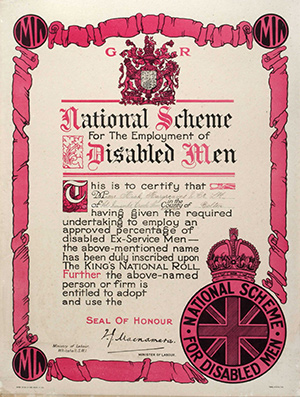WW1 Armistice Exhibition - After the war
Returning to civilian life
The Armistice did not mean an immediate return to civilian life, regulars who were fit had to complete their agreed period of service. Volunteers and conscripts wished to go home immediately but clearly it was impossible to process so many men immediately.
At the time of the Armistice the War Office was reluctant to release any men preferring to wait until a Peace Treaty was signed. However, there was so much unrest among men anxious to return to civilian life and such an urgent need for men required in key industries needed for rapid economic recovery that release began as early as January 1919 well before the Peace Treaty was signed.
Men with scarce industrial skills were released swiftly and those who had volunteered early in the war were given priority treatment, leaving the conscripts -particularly the 18-year olds of 1918 until last.
Most of the service men were soon back in civilian life. On 11th November 1918 the British Army numbered 3.8 Million men, one year later it numbered 900,000 and by 1922 just 230,000
Most discharged men were put in Class Z Army Reserve.
.jpg)
UNREST AND RIOTS
Grievances over what were perceived as unfairness in the de-mobilisation system gave rise to several disturbances.
There were minor mutinies in British Army camps in both Calais and Folkestone,3000 men took part in a demonstration in Central London.
More serious trouble often involved soldiers from the Empire who were often kept waiting for long periods until transport could be arranged. In March 1919 Canadian soldiers in Rhyl mutinied and order was only restored after several deaths. A few months later Canadian soldiers rioted in Epsom and broke into a police station killing one policeman
In Cardiff and Liverpool in June 1919 race riots occurred. The local white population clashed with black workers and seamen who it was felt had taken their jobs. In Cardiff in particular white ex-servicemen, including Australians stationed in the area, headed lynch mobs terrorising the black population. The trouble lasted over a week leaving three dead and dozens injured.
As late as 1920 the Army was making plans in the event of Soviet style government being set up in Liverpool.
 EMPLOYMENT
EMPLOYMENT
Many employers kept jobs open for returning servicemen and actively encouraged them to rejoin their businesses by placing adverts in local newspapers stating that their jobs were still open to them.
Other businesses however were reluctant to employ ex -servicemen fearing that may well be re-conscripted. It was initially only an Armistice not Peace. This was such a problem that the War Office had to publish a document to clarify the discharge terms of servicemen to re-assure employers
Some women who had taken up men’s jobs during the war were reluctant to give them back to returning servicemen.
To assist disabled servicemen to find employment in 1919 the government set up a scheme to persuade businesses to ensure that at least 5% of their employees were disabled ex-servicemen. Any business participating was allowed to display a Seal of Honour.
SUPPORT GROUPS
Discharged and de-mobilised personnel joined various groups for mutual support and to represent their rights. Initially the authorities viewed some of the groups formed with suspicion, they were well aware not only of the disturbances caused in Germany by returning soldiers but also principally of the Bolshevik Revolution in Russia
The main support groups were:-
- The National Association of discharged Sailors and Soldiers, formed 1916
- The National Federation of discharged and de-mobilised Sailors and Soldiers, formed 1917
- Comrades of the Great War, formed 1917
- Officers Association, formed 1921
On 15th May 1921 these organisations merged to form The British Legion which became the Royal British Legion 50 years later.
 PAPER WORK
PAPER WORK
Prior to leaving his unit each serviceman would be medically examined and issued with documentation.
The documents were designed to achieve several purposes:
- An orderly departure from the Army, with all pay issued kit and allowances settled.
- To provide an identity certificate, civilians already had one
- To claim benefit for any disability he may have received as a result of his period of service
- To help them find employment, including mention of gallantry awards and skills or trades previously held or learnt during service
- To establish domestic contact details in case he was required to rejoin in the event of an emergency (it was only an Armistice)
.jpg)
Other pages in this section:
After The War - Early Battlefield Tours - The Khaki Election - The Treaty Of Versailles - Frittenden War Memorial
- copyright © 2024
- Site by lancefrench.com